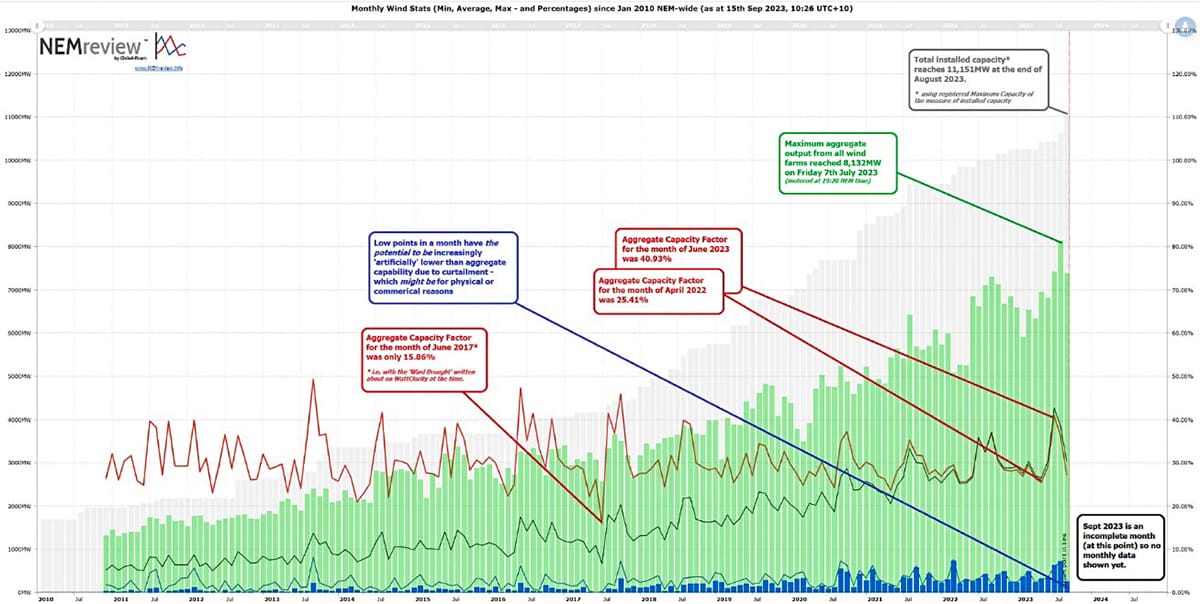Table of Contents
If you’ve ever watched anyone flush their bennies down the one-armed bandits, you’re familiar with the mindset. Now matter how many thousands they lose, all they focus on is the 10 bucks they won, once or twice.
The demented cultists of ‘Net Zero’ are just like that.
Last week the Net Zero universe was alive with the sounds of jubilation as the penetration of unreliable energy into the grid established a new record almost every day. The high point now stands over 74 per cent after a sunny and windy weekend. These are looking at the world through the wrong end of the telescope. They ignore the low points of wind and solar penetration that show whether or not we are making progress towards a coal-free grid.
The biggest lie the rent-seekers and clueless media chatterers peddle in regard to ‘renewables’ (a pointless and contradictory term) is ‘capacity’. Read any press-release-regurgitated-as-news and you’ll invariably be sold a line on ‘capacity’ and ‘enough to power X homes’. It’s all apples and oranges for the purpose of selling lemons to the gullible.
‘Capacity’ is a theoretical term: the amount the installation can theoretically supply at maximum output. It’s like the speedo dial on your family sedan that has a maximum reading of 260 km/h. Theoretically, if you absolutely caned it, it might get to that speed, but everything from the laws of physics to the local speed limits means you’ll never do it in reality.
It’s the same with ‘capacity’. Just look at the graph below to see the growing gap between capacity and actual delivery of wind installations in Australia’s National Energy Market. On average, the windmills output less than one-third of their capacity. Worse, the bottom line shows the lowest point of delivery for each month. Installing more and more ‘capacity’ has barely moved that line.
In other words, ‘wind droughts’ are a near-constant.

Wind droughts can be catastrophic for a ‘Net Zero’ grid. In June 2021, for instance, Britain’s much-vaunted wind farms delivered almost no power for a month – at the height of summer when elderly people, especially, desperately need air-conditioning.
At that moment wind droughts emerged as an existential threat to the continuous flow of electricity which is the lifeblood of modern civilisation.
Aided and abetted by clueless politicians and malicious activists.
The politicians and their advisers compounded the negligence of the meteorologists when they didn’t check the supply of wind before they set in train policies which will cost trillions of dollars to make electricity more expensive and less reliable […]
They expect wind droughts to be handled by big batteries and synchronous condensers.
In other words, if they just max out the credit card, the big jackpot that’s just around the corner will make up for all their losses.
Several teams on the dark side have used extremely sophisticated methods and gigantic data sets covering that period to discover, to their satisfaction, that we can probably get rid of coal in a decade or two at a modest cost. These academic studies have so far eluded public deconstruction; the notorious CSIRO GenCost study and the infamous Integrated System Plan from AEMO have not been so lucky.
The Energy Realists of Australia have done the job in a simpler way on the back of an envelope. Consider a long winter night of 16 hours with no useful solar input to serve the base load of 20G. Eliminate coal (imagine this is 2050) and gas as well (too expensive outside the peaks at dinnertime and breakfast), two or three GW of hydro (can’t ramp up further for fear of draining the dams) and one GW of wind because the Capacity Factor than night was 7.5 per cent (of 11GW installed capacity).
That calls for more than 250 GWh of storage for a single night and four times as much for the worst case where the drought persisted for four days and nights. Cost that at half a billion per GWh for battery storage, or maybe a billion per GWh to allow for additional wiring and installation costs. Repeat after ten years and consider that the demand for power is expected to double by 2050. Do the arithmetic and run it past Treasury for comment.
This is why, as I always say, the Climate Cult are allergic to myth-busting back-of-the-envelope calculations.









